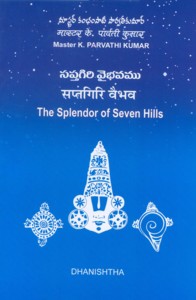Book Presentation
"The Splendor of Seven Hills"
by Dr. K. Parvathi Kumar

This is the talk given to the European brotherhood on the occasion of their tour to Tirumala with Dr. K. Parvathi Kumar in January 1995. The entire group walked up the hills to experience the splendor and significance of the Seven Hills.
The Seven Hills represent the seven centres of human awareness and seven planes of existence of creation. Dr. K. Parvathi Kumar explains their significance of the benefit of the Seekers.
Trilingual edition: English, Hindi, Telugu. Dhanishtha Edition, Visakhapatnam, 2004.
- Book order information
- About the Author
- Online Books K. Parvathi Kumar
- We have a few English copies to distribute for free.
Sample:
The Splendor of Seven Hills. ExtractThe Temple of Sripathi, known as Tirupati, is a temple of great spiritual significance. Thiru in Tamil stands for Sri in Sanskrit. Sripathi means the Lord that presides over Sri. Sri means the mother Divine in all her three aspects, viz. Lakshmi, Saraswathi and Parvathi (Cosmic Love, Cosmic Wisdom and Cosmic Will). Sri stands for the primordial light - Adithi, known as the Light that is responsible for all the successive manifestations in Creation and is the only knowable form of the Lord. The Lord absolute is the basis for the Light and the Light in turn is the basis for all Creative processes. The Lord absolute can only be perceivable upto His light and whenever Light is present, it should be understood that it is the Lord himself present. For example-we feel the presence of Electricity when it functions through its instruments. There is no other way to perceive Electricity, likewise the Lord absolute too. This primordial light called Sri in Vedic terminology details into Trinity and their consorts. They are popularly known as Brahma, Vishnu and Maheshwara and their consorts Saraswathi, Lakshmi and Parvathi.
To reach the primordial light and thereby feel the presence of the Lord, there is a specific discipline conceived by the Seers of the ancient times. The discipline is called the PATH and is known to those who follow it. The pilgrimage to Lord Venkateswara by foot, by walking through the Seven hills, enables one to ascend the seven steps of the Path and thereby land in the presence of Lord at the center of the Temple. The seven steps to be ascended are the seven planes of existence and the Path of Yoga pervades it, which is also filled intermittently at every stage by the Pilgrims of all times. It is these Pilgrims who conceived the Plan relating to the Lord of Seven Hills. Seven are the planes of existence while the Lord beyond and within the Creation is the Eighth.
The pathway to the temple can give the experience of all the seven planes provided one is deeply observant. The Hill-One represents the physical plane of existence and is considered difficult to ascend. The initial steps of ascent are more difficult than the subsequent ones, for the gross physical imprisons the consciousness stronger. Today, man is mostly concerned about his physical requirements and therefore does not live upto the seven planes, which do exist in him. Man does not perceive beyond his individualistic thoughts, his personal emotions and his personal, physical requirements. In fact, everything is oriented towards the physical existence while there is subtle, immortal existence of man within himself. The first hill represents all these difficulties followed by the second and third which are fairly cooperative to those who do not live in physical requirements. The mind and the senses when not so much oriented towards the physical, they get oriented in the upward direction, which is subtle, colourful and less mundane. …
During the midnight and post midnight hours, one can experience the Celestial music in the depths of the valley. Courageous ones experienced many such Soul music ragas and nadaas, when they dared to enter into the bottom of the valley with utmost faith. It is believed that groups of celestial beings gather in these valleys and sing the glory of the Lord. It is very challenging to the Pilgrim on the path to orient to the silence of this valley, while there is the busy movement of motor vehicles. This requires an additional discipline to be silent amidst noise. Those who are silent in the intellectual, mental, emotional and vocal planes can hear the voice of silence. To such ones silence ‘is’ at all times. The sound is nothing but a temporary disturbance to silence. As between the fifth and sixth hill, the beauty of the sound of silence is to be experienced while as between the fourth and fifth hill the beauty of the Light is experienced.
These hills as said earlier provide the phased experience of Light. While the first three hills relate to physical, emotional and mental awarenesses and experiences, the fourth and the fifth hills give the graded experience of Light and Sound.
At the end of this roadway, emerges an astoundingly steep hill, which seems to scare the pilgrims. But if one starts climbing, he finds that it does not need one-seventh of the effort that he made for the first hill. But the climbing of the sixth hill is esoterically considered difficult. The steep steps of this hill are indicative of it. Man has to transcend his ego (personality), without which the ultimate experience of entering into the Kingdom of God (Seventh hill) is not possible. This is the hill one can transcend with the help of the mantram, Soham. Soham is, Saha-Aham, meaning ‘That I am’. ‘That’ is the name of God and each Soul has to identify itself with ‘That’. The ocean emerges as wave. The wave is essentially the ocean. It has no existence without ocean. It is verily the ocean. Ocean only exists as wave. Ocean only is wave. God only exists as man. Man looses his identity into God. Bridging man to God and God manifesting into man is accomplished through the thought ‘That I am’, Soham. If one climbs the sixth hill with this spirit, to him the Seventh hill is one of the beauties of Kingdom of God, i.e. Vaikunttha.
The eighth one who is beyond the seven planes is at the center of it, represented by the Lord and the temple.
As one approaches the Temple, especially in the evening hours, when the Light is giving way to night, the temple splendidly shines and even before one reaches the temple, he once again finds the small temple of Hanuman. The Sadguru thus guides the seeker on the path up to the doorstep of the temple and wishes him well to meet the Lord. The Sadguru himself stands with folded hands orienting to the Lord. One should pay his respects to the Sadguru and express gratefulness before he walks towards the temple. The path to the Lord is safely walked through at every point under the noble guidance of the Sadguru and hence at no point Sadguru can be ignored. In truth, it is the Lord himself that guides every Soul to Himself in the form of Sadguru. The one who does not realise the Lord in the Sadguru, cannot realise the Lord. Inability for such realisation is due to disability to dissolve the person. The final experience of the Lord at the temple is according to the blessings received from the Sadguru. Such is the way of the Seven Hills. …

 Circle of Good Will
Circle of Good Will Contact
Contact
